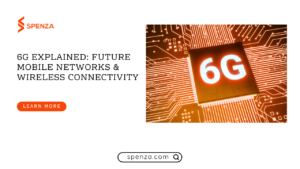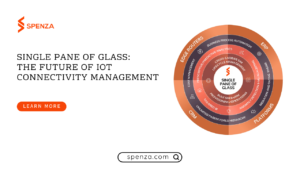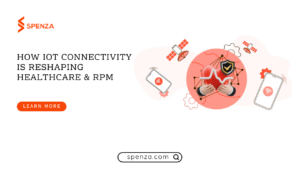TL;DR / At-a-Glance Summary
The Operational Overload of IoT at Scale
When you have tens of thousands of devices across multiple countries and carriers, management becomes fragmented, slow and opaque.
Why It Matters Now
The number of connected IoT devices is exploding globally, and without unified visibility you risk higher costs, security gaps and wasted time.
“Single Pane of Glass” (SPOG) Means
It’s more than one dashboard: it’s unified monitoring, management, billing, analytics and automation across all networks and carriers.
What to Look For
A platform that offers features like global carrier support, eSIM orchestration, bulk provisioning, real-time alerts and cost control.
Transforming IoT Operations into a Strategic Advantage
A unified IoT connectivity platform turns operations from a burden into a strategic asset: faster issue resolution, lower spend, full visibility, better security and easier scaling.
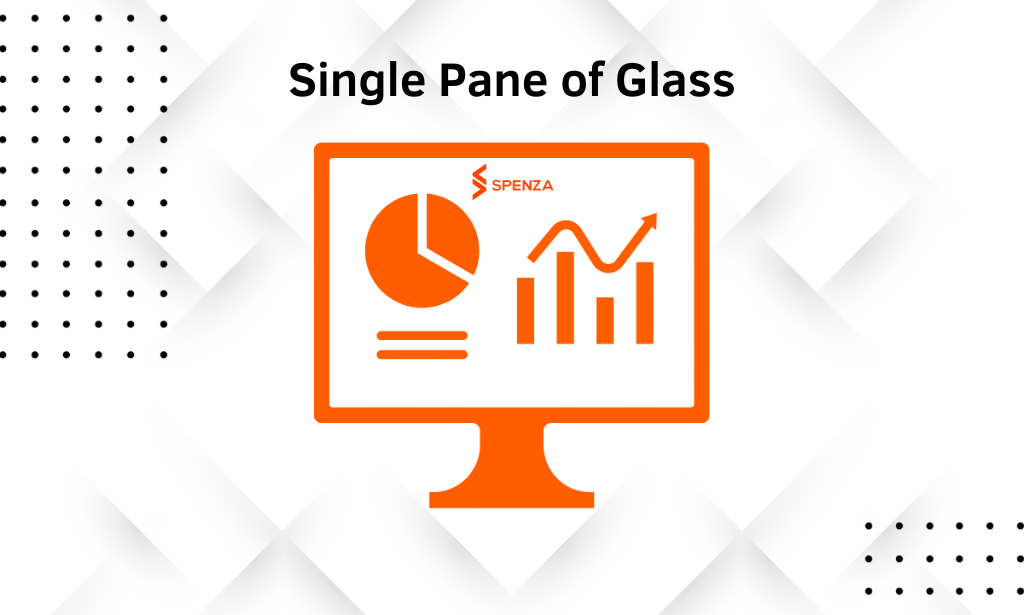
Global IoT Management at Scale Is Breaking Enterprises
Your IoT deployment was supposed to drive efficiency. Instead, your operations team is drowning in complexity.
You have 50,000 connected devices spread across 12 countries, running on eight different cellular carriers. Each carrier has its own portal, its own billing format, and its own way of reporting usage data. Your IT director spends three days each month just reconciling invoices. When a device goes offline in Brazil, you discover the problem four days later because no single system shows you real-time connectivity status.
This is the hidden tax of the IoT scale. And it is costing you more than money. It is costing you visibility, control, and competitive advantage.
The solution? A Single Pane of Glass (SPOG) platform that unifies your entire global IoT connectivity ecosystem under one dashboard, one workflow, and one source of truth.
What is Single Pane of Glass (SPOG)?
Single Pane of Glass (for IoT) refers to a unified connectivity management platform that consolidates data, device monitoring, carrier management, billing, and operational controls into a single, centralized interface. It provides enterprise teams with a holistic, real-time view of all connected IoT devices across different networks, carriers, and regions without the need to switch between multiple dashboards or systems.
This centralized approach simplifies management, enhances visibility, strengthens security, and streamlines troubleshooting and performance monitoring across the entire IoT ecosystem.
A true Single Pane of Glass does not just aggregate data. It normalizes it, enriches it, and makes it actionable across departments — including IT, operations, finance, and customer support.
Why it matters now
- Scale: Connected IoT devices grew to 18.5B in 2024 and are on track for 21.1B in 2025. Fragmentation multiplies with scale.
- Global ops: Cellular IoT has nearly 4B connections already and continues to expand across NB-IoT and Cat-M. More regions means more carriers and contracts to manage
- Security: Nearly half of network connections involving IoT are high-risk if unmanaged. Visibility and policy enforcement from one place lowers exposure.
12 Essential Features of a True Single-Pane-of-Glass IoT Platform

When it comes to IoT connectivity, not every platform truly delivers on the promise of unified management. A real single-pane-of-glass solution should simplify your entire IoT ecosystem, not complicate it.
Here are the 12 core features to look for when choosing your IoT connectivity platform:
- Unified Management
Bring all your IoT SIMs together under one roof. A single, unified interface gives you full control and visibility over your connected devices, making operations simpler and faster. - Global Integrated Ecosystem
Your platform should connect you to the world. Look for one that supports hundreds of mobile network operators and satellite providers, ensuring seamless global coverage. - Consistent User Experience
A common interface across teams means less training, fewer errors, and more consistency in how your organization manages IoT connectivity. - Cross-Carrier SIM Lifecycle Management
Manage your entire SIM fleet from one place. From provisioning and monitoring to cost tracking, get real-time insights and full control across multiple carriers. - Bulk SIM & eSIM Provisioning
Whether you’re activating 10 SIMs or 10,000, bulk provisioning saves time. Execute activations, deactivations, suspensions, and rate-plan changes without worrying about network restrictions. - eSIM Orchestration and Management
Simplify eSIM management with centralized profile workflows. Get real-time visibility into devices, carriers, and subscriptions—all in one dashboard. - Scalability and Future-Proofing
Choose a platform built for growth. Compatibility with GSMA SGP.32 standards and OEM partnerships ensures your solution scales easily across regions and technologies. - Advanced Analytics
Turn your data into decisions. Built-in analytics tools should deliver insights through dashboards, ad-hoc queries, and even predictive and prescriptive analytics. - Anomaly Detection and Automated Alerts
Don’t wait for problems to find you. Smart anomaly detection automatically flags irregularities in connectivity or usage and can trigger alerts or automated actions via SMS or email. - Business Process Automation
Your IoT platform should fit into your business—not the other way around. Integrate CRM, ERP, and data systems to synchronize information and streamline operations. - Cost Management and Control
Get a clear picture of your connectivity spend. Line-level cost allocation and enriched data views (by customer, business unit, or region) make budgeting and forecasting effortless. - Invoice Management
No more juggling invoices from multiple providers. A unified platform consolidates all partner invoices, simplifying reconciliation and reporting.
The Hidden Costs of Fragmented IoT Management
Before we explore solutions, let’s quantify the problem. Enterprises managing IoT connectivity without a unified platform face compounding operational inefficiencies:

1. Time Drain Across Multiple Portals
Your operations team logs into 5 to 15 different carrier portals daily. Each has unique authentication protocols, different user interfaces, and inconsistent data formats. A task that should take 10 minutes (like checking device status across your fleet) becomes a 2-hour exercise in portal-hopping and spreadsheet reconciliation.
2. Billing Chaos and Hidden Overages
You receive invoices from multiple carriers in different currencies, billing cycles, and formats. Without unified visibility:
- Overages go undetected until bills arrive
- Inactive devices continue accruing charges (stranded assets)
- Rate plan optimization opportunities are invisible
- Invoice errors go unchallenged
Industry data suggests enterprises waste 15% to 30% of their IoT connectivity budget on preventable billing inefficiencies.
3. Security and Compliance Blind Spots
When you cannot see all devices in real time, you cannot secure them. Rogue devices, unauthorized data usage, and compliance violations remain hidden until they become critical incidents. In regulated industries like healthcare or finance, this creates unacceptable risk.
4. Delayed Issue Resolution
A manufacturing sensor goes offline in Germany. Your team discovers it three days later when the production line reports anomalies. Without real-time monitoring and automated alerts, you are always operating reactively, never proactively.
5. Scaling Roadblocks
Every new country, carrier, or device type adds another layer of complexity. Expanding to Southeast Asia? That means negotiating with three new carriers, onboarding three new portals, and training your team on three new systems. Growth becomes a burden, not an opportunity.
Top 5 Benefits of a Unified Connectivity Platform
For many enterprises, managing IoT connectivity feels like a constant juggling act—different carrier portals, multiple invoices, scattered data, and endless manual tasks. A unified IoT connectivity management platform changes that. It turns IoT from an operational burden into a strategic growth engine.
Here’s how it transforms your business across efficiency, financial control, and agility—with real-world impact.
1. Radical Operational Efficiency
A single pane of glass replaces fragmented workflows. What once took hours across multiple systems now takes minutes from one dashboard.
| Metric | Fragmented Management | Unified IoT Platform |
|---|---|---|
| Time to check fleet status | 90–120 minutes (multiple portals) | 3–5 minutes (one dashboard) |
| Invoice reconciliation | 2–3 days per month | 2–3 hours (automated) |
| Time to detect device failures | 24–72 hours (manual checks) | Real-time (automated alerts) |
| New carrier integration | 4–8 weeks (custom setup) | 1–3 days (prebuilt connectors) |
| Cost visibility | Fragmented by carrier | Unified, real-time analytics |
Example:
Before, a U.S.-based logistics company spent nearly 50 hours a month activating SIMs, suspending devices, and compiling usage reports across four carriers.
After adopting a unified platform, that same team does it all in under five hours. With automation and APIs, they now manage 15,000 SIMs across AT&T, Verizon, and T-Mobile—from one dashboard.
2. Total Financial Control
A unified platform delivers full visibility into global costs and usage, helping eliminate waste and avoid bill shock.
Before: A California manufacturer received a surprise $10,000 invoice after devices in Mexico overconsumed data—something the team couldn’t see in real time.
After: They now monitor all carriers in one place, setting global rules like, “Suspend any SIM using more than 100MB in 24 hours.”
The results speak for themselves:
- 20–35% reduction in total connectivity spend
- Elimination of stranded devices still incurring costs
- Real-time overage prevention through automated alerts
- Consolidated invoicing into one unified bill
3. Complete Global Visibility
When every device and SIM is visible in one interface, global operations become easier to manage and troubleshoot.
Before: A U.S. energy company had to call local European carriers to troubleshoot field sensors, waiting 48 hours for status updates.
After: They click a device in their dashboard to see its 24-hour connectivity history, signal strength, and real-time network status—often resolving issues in minutes.
This level of transparency allows teams to make data-driven decisions about device placement, carrier selection, and service optimization.
4. Unified, Ironclad Security
With multiple carrier portals, enforcing consistent security is nearly impossible.
Before: Teams manually configured IP whitelists and VPN rules per carrier, risking gaps and inconsistencies.
After: A single, unified policy locks every SIM on every network to your private IoT network. That means end-to-end security, simplified compliance, and peace of mind across geographies.
5. True Scalability and Strategic Agility
A unified platform isn’t just about management—it’s about momentum.
- Expand into new markets without renegotiating carrier contracts
- Switch providers based on performance, not lock-in
- Launch new IoT products faster with proven connectivity infrastructure
Example: A U.S. EV startup launching in Europe cut its go-to-market time from six months to just two weeks. Its multi-carrier SIMs were preconfigured for local networks, and the unified platform handled provisioning instantly.
Scalability becomes effortless—you just ship your devices, and the platform takes care of the rest.
Ready to see your global IoT fleet in one view? Book a demo of Spenza’s SPOG platform.
Turning IoT Into a Strategic Asset
A unified IoT connectivity platform doesn’t just make operations smoother—it redefines what’s possible.
It brings together every SIM, every carrier, every device, and every cost into one intelligent system.
The result:
- Faster operations
- Lower costs
- Stronger security
- Real-time visibility
- Instant scalability
For modern enterprises, this isn’t just convenience—it’s competitive advantage.
Before vs After: what changes when you unify
| Area | Carrier-by-Carrier | Single Pane of Glass IoT |
|---|---|---|
| Provisioning | Different portals and steps per carrier | One workflow across carriers |
| Plan optimization | Manual spreadsheet work | Automated pool and plan suggestions |
| Incident response | Ticket ping-pong with vendors | One queue with root cause context |
| Invoicing | Multiple formats and currencies | Consolidated bill and line-level audit |
| eSIM rollout | Country by country logistics | Remote profile download and swaps |
| Security posture | Partial device visibility | Central policies and anomaly alerts |
How Spenza Delivers True Unified IoT Connectivity Management
Spenza is an operator-neutral connectivity enablement platform that combines three pillars in one place:
- Unify for IoT aggregation and spend control
- Monetize for telecom-as-a-service and white-label resellers
- Grow for MVNE enablement so OEMs can bundle and sell connectivity
This integrated path lets enterprises start with cost control, add smarter procurement, then launch branded connectivity services when ready.
Spenza has built its platform specifically to solve the multi-carrier IoT management challenge facing global enterprises. Here is how it works:
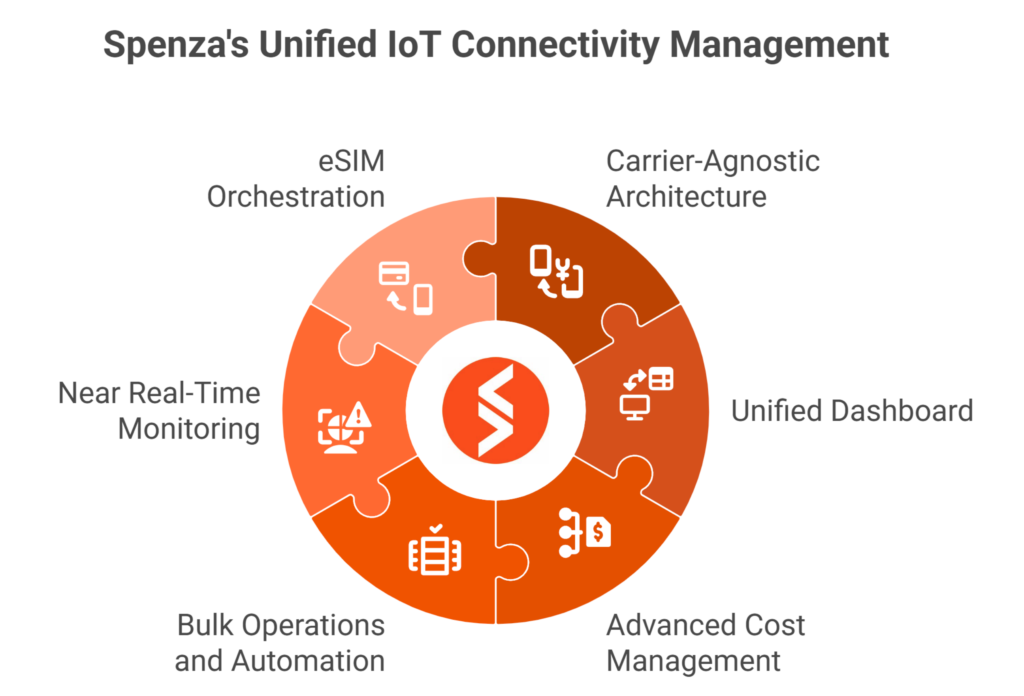
1. Carrier-Agnostic Architecture
Unlike carrier-owned platforms that lock you into a single network, Spenza is operator-neutral. You can:
- Bring Your Own Network (BYON): Integrate your existing carrier contracts
- Access Spenza’s marketplace: Source connectivity from 250+ global and regional carriers
- Mix and match: Use different carriers for different device types or regions
- Switch seamlessly: Change carriers without changing platforms
This flexibility gives you negotiating leverage with carriers and prevents vendor lock-in.
2. Unified Dashboard for Global Visibility
Spenza’s Single Pane of Glass IoT interface provides:
- Real-time fleet status across all carriers and geographies
- Cross-functional access: IT, operations, finance, and customer support teams all work from the same data
- Standardized processes: No more learning new workflows for each carrier
- Customizable views: Filter by region, carrier, device type, or business unit
3. Advanced Cost Management Controls
Spenza’s financial tools include:
- Automated rate plan optimization: Machine learning algorithms analyze usage patterns and recommend optimal data plans
- Invoice consolidation: One bill for all carriers, all regions
- Line-level cost allocation: Track costs by customer, business unit, or device
- Stranded asset detection: Identify and deactivate devices no longer in use
- Real-time budget tracking: Set spending limits and receive alerts
Customers typically see 20% to 30% reduction in connectivity costs within the first billing cycle.
4. Bulk Operations and Automation
Spenza’s patented technology enables:
- Unlimited bulk actions across multiple carriers simultaneously
- Approved workflows: Require manager approval for sensitive operations
- Scheduled provisioning: Automate activations tied to customer orders or production schedules
- API integrations: Connect to ServiceNow, Salesforce, ERP systems, and more
5. Near Real-Time Monitoring and Alerts
Spenza’s anomaly detection engine provides:
- Custom alert rules (usage spikes, connection failures, geographic anomalies)
- Multi-channel notifications (SMS, email, Slack, webhook)
- Automated remediation: Trigger provisioning actions based on alerts (suspend device, switch carrier)
- Historical analytics: Identify patterns and prevent recurring issues
6. eSIM Orchestration
As devices shift from physical SIM cards to eSIM technology, Spenza provides:
- Centralized profile management for remote SIM provisioning
- Real-time carrier switching without physical intervention
- SGP.32 standard support for new device onboarding
- Instant scalability across geographies and carriers
According to GSMA Intelligence , eSIM adoption in IoT is expected to grow from 1.2 billion connections in 2023 to over 6 billion by 2030. Platforms that cannot orchestrate eSIM at scale will become obsolete.
Conclusion: Turning IoT Complexity into Strategic Advantage
In today’s hyper-connected world, enterprises no longer succeed simply by adding more devices but by controlling them. A fragmented IoT connectivity environment with multiple billing portals, carrier dashboards and inconsistent visibility is not just inefficient—it’s a strategic liability.
By adopting a true “Single Pane of Glass” IoT connectivity platform, organisations gain a unified dashboard that normalises data, streamlines workflows, automates carrier management and brings financial clarity.
This kind of integrated solution delivers powerful benefits: real-time fleet monitoring, instant anomaly detection, cost optimisation, seamless global expansion and iron-clad security all from one interface.
If your IoT deployment still looks like 50,000 devices, 8 carriers, 12 countries and endless spreadsheets then you’re not scaling you’re drowning. It’s time to move from chaos to control.
With the right connectivity management strategy, IoT becomes not just operational but transformational. Choose a platform built for global scale, carrier-agnostic flexibility and full-lifecycle automation, and turn your IoT operations into a competitive advantage.
FAQs
Yes. Spenza supports Bring Your Own Network while also offering a marketplace for new plans when you want them.
Spenza offers a carrier-agnostic, cloud-native platform that enables global device coverage, unified dashboards for all SIMs and carriers, automated cost-control and real-time fleet monitoring — all designed to simplify large-scale IoT operations.
Book a demo to see how Spenza’s unified IoT management platform simplifies your global operations.


